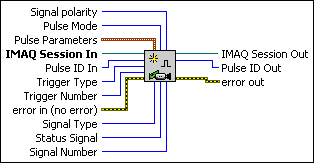IMAQ Generate Pulse3 VI
Installed With: NI Vision Acquisition SoftwareGenerates a pulse on a trigger line. IMAQ Generate Pulse3 can generate a pulse immediately or on the assertion edge of a status or trigger signal. Each trigger pulse uses a Pulse ID, which is automatically generated each time you call this VI.

 |
Signal polarity specifies the polarity of the status or trigger signal parameter. The following values are valid:
|
||||||||||||||||
 |
Pulse Mode specifies if the pulse is repeated. The following values are valid:
|
||||||||||||||||
 |
Pulse Parameters specifies the parameters used to describe a pulse.
|
||||||||||||||||
 |
IMAQ Session In identifies the device. |
||||||||||||||||
 |
Pulse ID In identifies the Pulse Id input. This parameter is used only when Mode is set to Stop. |
||||||||||||||||
 |
Trigger Type specifies the type of the trigger signal. The following values are valid:
|
||||||||||||||||
 |
Trigger Number specifies the number of the trigger. |
||||||||||||||||
 |
error in (no error) describes error conditions that occur before this VI or function runs. The default is no error. If an error occurred before this VI or function runs, the VI or function passes the error in value to error out. This VI or function runs normally only if no error occurred before this VI or function runs. If an error occurs while this VI or function runs, it runs normally and sets its own error status in error out. Use the Simple Error Handler or General Error Handler VIs to display the description of the error code. Use error in and error out to check errors and to specify execution order by wiring error out from one node to error in of the next node.
|
||||||||||||||||
 |
Signal Type specifies the type of signal that causes the pulse to be generated. The following values are valid:
|
||||||||||||||||
 |
Status Signal specifies the signal that causes the pulse to be generated if Signal Type is set to Status. The following values are valid:
|
||||||||||||||||
 |
Signal Number specifies the number of the trigger line that causes the pulse to be generated if Signal Type is set to one of the trigger types. |
||||||||||||||||
 |
IMAQ Session Out has the same value as IMAQ Session In. |
||||||||||||||||
 |
Pulse Id Out identifies the Pulse Id output. |
||||||||||||||||
 |
error out contains error information. If error in indicates that an error occurred before this VI or function ran, error out contains the same error information. Otherwise, it describes the error status that this VI or function produces. Right-click the error out indicator on the front panel and select Explain Error from the shortcut menu for more information about the error.
|
Details
Only the NI 1409, NI 1410, NI 1422, NI 1424, NI 1426, NI 1427, NI 1428, NI 1429, NI 1430 and the NI 17xx smart cameras can generate pulses.
- The NI 1409, NI 1410, NI 1422, NI 1424, NI 1426, and NI 1428 can generate a maximum of 2 pulses.
- The NI 1427 and NI 1429 can generate a maximum of 3 pulses.
- The NI 1430 can generate a maximum of 6 pulses.
- The NI 17xx smart cameras can generate 2 pulses.
These pulse generators can be automatically configured by NI-IMAQ for generating pulses used to control the camera. In these cases, the VI returns the Exhausted Resources error when the total number of pulses is greater than the maximum number of pulses supported.







